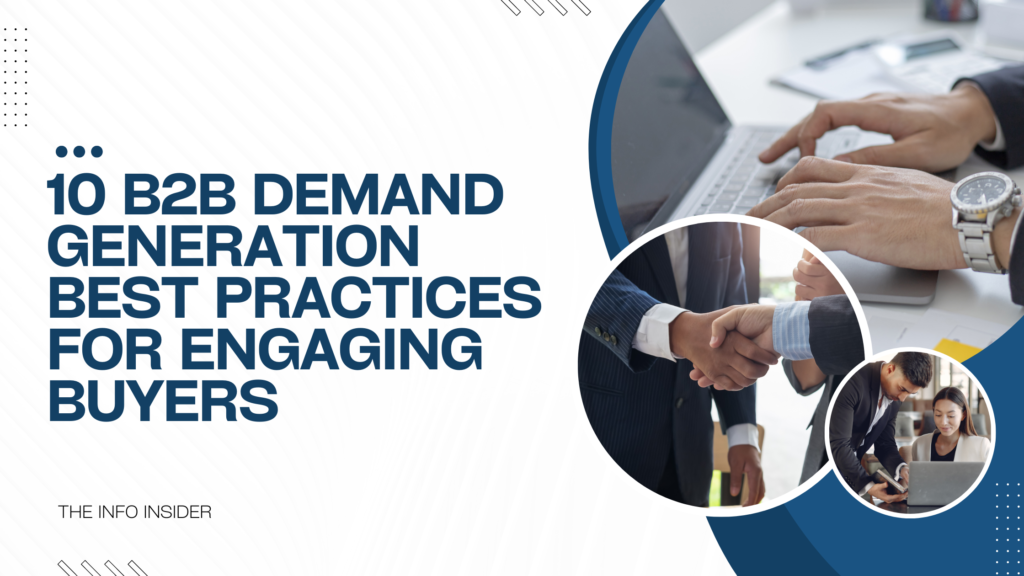For most growth-oriented B2B marketers and organizations, demand generation is a top priority in their marketing strategy, crucial for actively engaging customers throughout their entire buying journey. For instance, 22% of marketers intend to increase their demand gen budgets by 10% in 2024, while 20% are looking at an increase of over 11% (Demand Generation Benchmark Survey, 2023).
This definitive guide is designed to equip you with proven B2B demand gen strategies, helping your business to attract and nurture high-quality leads.
10 B2B Demand Generation Best Practices
1) Incorporate a Well-Planned Content Marketing Strategy
Building and executing a robust content marketing plan is essential for a successful B2B demand generation campaign. According to INFUSE Insights’ Voice of the Buyer (2024), 40% of buyers interact with an average of 4 to 6 pieces of content throughout their buying journey, emphasizing the importance of delivering a diverse array of valuable resources, such as though leadership blogs, webinars, eBooks, podcasts, and case studies, at all touchpoints.
By providing this variety, businesses can not only engage potential customers but also nurture them through their decision-making process, ensuring that each interaction adds value and guides them toward making a purchase.
2) Focus on Multi-Channel Marketing
Given that, 67% of the B2B buyer journey occurs in digital channels with multiple touchpoints influencing decisions (COMMERCETOOLS, 2024), a multi-channel marketing approach is non-negotiable for B2B organizations for customer engagement. Integrate various channels, such as email, social media, content marketing, paid advertising, and search engine optimization (SEO) to create a cohesive and comprehensive demand generation strategy.
3) Utilize Account-Based Marketing (ABM)
Account-based marketing is a powerful strategy where sales and marketing teams collaborate to target high-value accounts that represent significant revenue potential. Instead of marketing to a broader audience, ABM narrows the focus to a select group of target accounts. This allows you to tailor your approach and deliver personalized content and solutions that directly address the specific needs and pain points of these key accounts. By aligning your efforts closely with their specific requirements, ABM increases the likelihood of conversion and fosters deeper, more meaningful relationships.
4) Implement a Lead Scoring System
Lead scoring is a methodology used to rank leads based on their conversion potential. This process involves assigning scores to leads based on various attributes and behaviors, allowing sales and marketing teams to prioritize their efforts and target the most promising prospects for their products or services. By implementing a well-designed lead scoring system, you can improve lead quality, boost sales efficiency, and drive revenue growth.
5) Build a Powerful Email Drip Campaign
An email drip campaign is an automated marketing strategy designed to nurture leads and drive conversions. By sending a series of targeted emails over time to leads who’ve shown interest in your brand, you can educate potential customers, build trust, and guide them through the sales funnel.
6) Leverage Influencer Marketing
Influencer marketing has emerged as a powerful tool for B2B marketers seeking to reach their target audience and drive demand. A 2022 study by Zen Media underscored the significant ROI potential of this strategy, with some B2B influencer marketing programs achieving a remarkable 520% return on investment. This highlights the effectiveness of collaborating with industry experts to increase brand visibility, build trust, and generate leads in the B2B space.
7) Invest in Event Marketing
Event marketing is a highly valuable marketing strategy for B2B organizations to increase brand visibility and generate new business opportunities. A 2024 study by Freeman 2024 found that 80% of attendees believe in-person events are the most reliable source for discovering new products and services. By participating in industry events, you can connect with potential customers, showcase your products or services, and establish yourself as a thought leader.
8) Use Intent Data to Target In-Market Buyers
Intent data is a highly effective demand generation strategy, giving businesses a deeper understanding of potential customers’ online behaviors. By analyzing activities such as website visits, search patterns, and content downloads, intent data can help businesses identify which organizations are actively exploring their products or services. With this information, the company can tailor its efforts to target these in-market buyers, increasing the likelihood of conversion.
9) Create a Referral Program
Another example of a B2B demand generation strategy is building a well-structured referral program. By encouraging your existing customers to refer new business, you can tap into their networks and drive high-quality leads.
10) Streamline with Marketing Automation
Marketing automation automates repetitive tasks like social media posting, email marketing, ad campaigns, customer segmentation, lead nurturing, and much more. This ultimately significantly improves efficiency, lead quality, and overall demand generation results.
Key Takeaways
- A successful B2B demand generation strategy requires a holistic approach that integrates diverse tactics to address every stage of the customer journey, from awareness to purchase decisions, maximizing the chances of conversion.
- Identify gaps in your competitors’ content and fill them with your own unique offerings. This can help you differentiate your brand, provide value to your audience, and attract new customers.
- Leverage technology to streamline processes, improve efficiency, and gain valuable insights. Utilize marketing automation, intent data platforms, and social media analytics to optimize your demand generation efforts.

